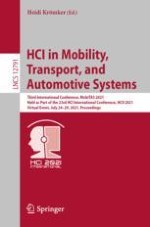2021 | Book
HCI in Mobility, Transport, and Automotive Systems
Third International Conference, MobiTAS 2021, Held as Part of the 23rd HCI International Conference, HCII 2021, Virtual Event, July 24–29, 2021, Proceedings
Editor: Heidi Krömker
Publisher: Springer International Publishing
Book Series : Lecture Notes in Computer Science
